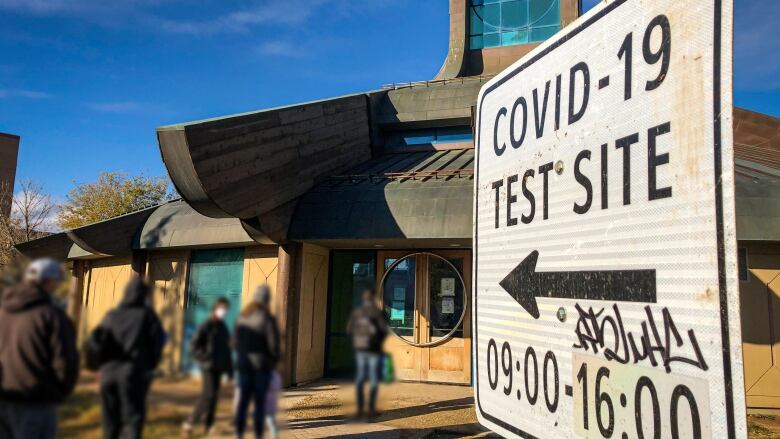Using a jerry can of water on a wildfire: Contact tracing during Winnipeg's new COVID-19 wave
Latest bottleneck in Manitoba's testing-and-tracing system may be compounding the spread of the disease

Since the start of the pandemic, Manitoba Public Health hasbeen playing a game of whack-a-mole with its COVID-19 testing and tracing system.
In April,Cadham Provincial Laboratory had trouble meeting the demand for the polymerase-chain-reaction tests thatreveal the genetic signature of the virus that causes COVID-19. At the end of the month, the province entered into a deal with private laboratory company Dynacare to open a new PCRlab of its own.
Together, Cadham and Dynacare can now process slightly more than 3,000 laboratory tests on a good day. But that additional lab capacity presented a problem when the number of symptomatic Winnipeggers started spiking.
In September, the demand for a COVID-19 test grew so high in the Manitoba capital, people waited as long as six hours for a public health nurse to insert a nasopharyngeal swab up one nostril. After weeks of complaints, the province contracted Dynacare to open a mobile swabbing site on Portage Avenue and also converted a former car dealership on Nairn Avenue into another swabbing facility.
The average waittime for a swab is now said to be dropping in Winnipeg, even if it's not ideal.
The latest bottleneck in the system involves contact tracing the process of identifying everyone who's spent a significant amount of time in close proximity to someone diagnosed with COVID-19.
Several COVID-positive Winnipeggers have reported waiting as long as a week after their test to begin the process of identifying all of their close contacts.
This is problematic, and not just because of the anguish it may cause a patient anxious to ensure every conceivable friend, family member and acquaintanceisnotified ofthepotential exposure.
Without a trace ...
When you're dealing with a highly contagious disease, a long delay in identifying contacts has the potential to compound the spread of that disease.
The geometry of contagion can not be collapsed if people exposed to the virus are not informed they too may be infected before they go out and potentially infect other people.
In other words,it's entirely possible the dramatic spread of COVID-19 in Winnipeg is not just due to the bar-hopping young adults, symptomatic workers and other ill-advisedManitobanswho fail to practise what Dr. Brent Roussin calls the fundamentals of pandemic hygiene.
The bottleneck in the contact-tracing stage may also be afactor in Winnipeg's continuing misery.
"We can't make this work ifonly the province oronly the individuals are doing the right things," said microbiologist Jason Kindrachuk, the Canada Research Chair in emerging viruses and a now-familiar figure to Manitobans engaged in the science behind the pandemic.
It was easier in April
Back at the end of March or early April, when most Manitobans who contracted COVID-19 did so while travelling abroad, it was relatively easy to conduct tracing. People returning from winter vacations tended to go straight into isolation when they got back to Canada and didn't rack up many contacts.
It's a completely different picture now in the Winnipeg health region, where an average of 70 new cases a day have been reported over the past week.
Travel is no longer a major vector for the spread of COVID-19 in this city. Most people are getting the disease from prolonged indoor exposure to close contacts and each infected person tends to have a lot more contacts than a returning vacationer did in the spring.
It is entirely understandable how a finite pool of contact tracers can fall behind on the task of keeping track of how the disease is spreading.
"It'slike you have a wildfire and you've got a jerry can of water and hope that it rains," Kindrachuk said of Winnipeg's contact-tracing task. "That's what you're battling against."
Back in April, the Winnipeg health region had a dedicated team of six contact tracers and was able to scale that complement up to 50 on demand.
Manitoba Public Health was unable to say this week how many people are now working as contact tracers, either directly for the province or on contract through the Canadian Red Cross.
For every solution, a new problem
Premier Brian Pallister said Wednesday he's unhappy with the latest bottleneck in the testing-and-tracing system
"I also acknowledge that they're happening around the world and certainly we're not the only ones that are having to face the challenge of improving our systems," Pallister said of the tracing delays.
"As you solve one bottleneck problem, you create another problem further downstream."
The premier, however, appeared to equate contact tracing with the task of notifying people about their COVID-19 test results.
"It concerns all of us when people are not able to get their test results back rapidly. So that's that's the focus of our improvements," he said.
It is important for people to learn quickly whether they've tested negative or positive. On Wednesday, the province began notifying positive patients online in an effort to speed up that process.
Contact tracing is a related task, but it'smuch more complicated than simply notifying a patient and providing that person with medical advice.
No public health authority on the planet appeared to be prepared for this pandemic. Every jurisdiction appears to be scrambling.
Still, if Manitoba can not scale up its contact-tracing workforce to meet the current demand, it could become even more difficultto get a handle on the spread of COVID-19 inWinnipeg.












_(720p).jpg)


 OFFICIAL HD MUSIC VIDEO.jpg)
.jpg)



























































































